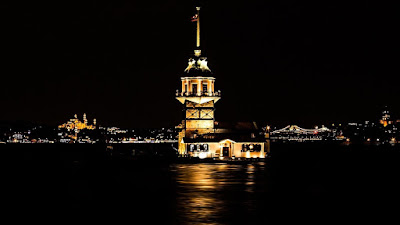On the 2010 book Harem Histories: Envisioning Places and Living Spaces, edited by Marilyn Booth:
The editor's introduction mentions the 1909 publication of Demetra Vaka Brown's Haremlik: Some Pages from the Life of Turkish Women. "If Vaka Brown exploited the drawing power of the harem as an image of exoticism and mystery for her North American friends and readers, she also sought to complicate that image for her readers, contrasting it with the 'hatred and scorn' she had heard Americans express toward Turkey, as they assured her that Turkish 'women [were] miserable creatures.'" And so this 2010 book, Harem Histories, asks how the harem and other "understandings of gendered space in the societies where the harem structured women's and men's lives" was represented in those societies. Not in outside societies that may have misunderstood or criticized it, but in the society of which the harem was a part, while acknowledging "perpetual cultural motion."
One of the essays is "Panoptic Bodies: Black Eunuchs as Guardians of the Topkapi Harem" by Jateen Lad.
- "In the enormous corpus of European harem literature and paintings, sharp-eyed eunuchs became a mandatory topos, their presence at the margins bringing to light the perversity of the scenario which they helped frame: the perfect, fair-skinned, and beautiful being entrusted to the incomplete, dark, and mutilated." (p. 137)
- The Topkapi harem was "precisely configured" and it was "all held together by a network of spaces guarded by the black eunuchs." (p. 150)
- "Thus, despite the black eunuchs' position at the margins, the architecture suggests that they were central to all comunication within the harem." (p. 165)
Marilyn Booth, editor. Harem Histories: Envisioning Places and Living Spaces. Durham & London: Duke University Press, 2010.
Also of interest:
"Closed to the public for more than a decade, the stunning Zeyrek Çinili Hamam has just reopened its wooden doors to the world. Located in Istanbul’s Zeyrek neighborhood – on the European side of the Bosporus, adjacent to the historic Fatih district – the bathhouse was built in the 1530s by Mimar Sinan, the architect-in-chief to illustrious Ottoman sultans such as Suleiman the Magnificent."
— The 500-year-old hamam bringing Istanbul’s past to life Alice Barnes-Brown, CNN, September 28, 2023
"The Hamam al-Samra, in the Al-Zeitoun neighborhood of northern Gaza, was said to have been built in the 14th century and was the only public bathhouse in the Gaza Strip. It was destroyed in an Israeli airstrike on December 15, [2023,] its owner, Salim Al-Wazeer, told CNN."
— Israeli military acknowledges destroying Ottoman-era bathhouse while targeting Hamas in Gaza, Ibrahim Dahman and Stephanie Halasz, CNN, December 30, 2023
You may also be interested in my nonfiction books about how eunuchs are treated in fiction and in nonfiction:
If you'd like to learn more about my work, I've published books. Also, I write for Medium. There, readers with a paid membership don't have to worry about the paywall.
